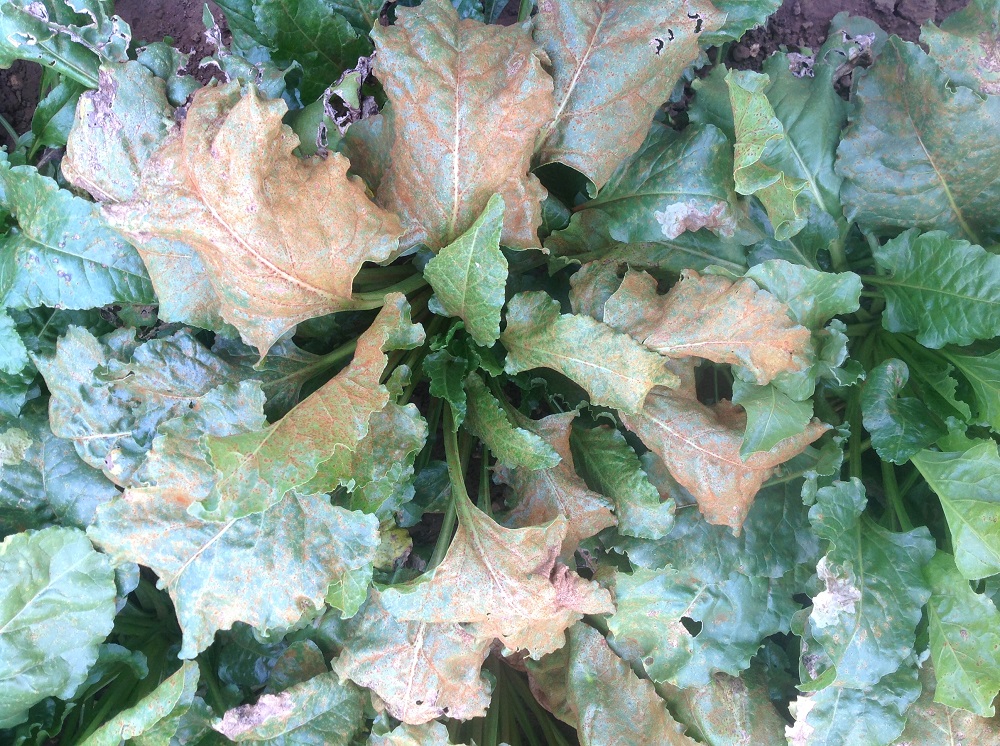It’s getting to that time of year again as T1 fast approaches in sugar beet. CPM finds out the latest advice.
Maintaining the canopy so that it’s healthy and vigorous is key to maximising sugar beet yields.
By Lucy de la Pasture
The appearance of the new disease Stemphylium at two East Coast locations in 2014, had the industry holding its breath last season. It’s a disease that has been prevalent in the Netherlands and giving beet growers quite a headache, with losses of up to 42% of sugar yield reported by Dutch researchers.
At a time when beet growers could really do with some good news, the fact that Stemphylium didn’t make an appearance in beet crops last year is just that, says BBRO lead scientist, Dr Mark Stevens.
“We’re still keeping a watching brief on UK crops and keeping a close eye on the situation in the Netherlands, where Stemphylium was again problematic in 2015,” he says.
Major beet disease
The threat of Stemphylium arriving as a major beet disease in the UK remains because infection is airborne. That means if there were to be a prevailing easterly wind from the Netherlands carrying the spores, then the only thing between it and the east coast of Britain is 126 miles of North Sea.
“There’s still a lot to learn about the epidemiology of Stemphylium and Dutch researchers are working hard on this, but we do know that if it does arrive in the country, then it can survive on common hosts once here,” he explains.
Stemphylium likes wet summers and high humidity, so vigilance in the field is important, especially when the crop is under stress from other factors, such as beet cyst nematode or low pH, he advises.
Leaf symptoms appear as small, discrete, irregular yellow spots (0.5-2mm across). The spots then begin to die from the centre, forming brown spots (1-3mm across). Infected leaves can die and new spots appear on young leaves, resulting in further leaf loss later in the season.
“Opera (epoxiconazole+ pyraclostrobin) is the only fungicide approved for use on sugar beet that has an incidental effect on Stemphylium. If you’ve any suspicions then send a sample to the Plant Clinic for identification,” he adds.
A more pressing problem this season is likely to be rust, which will be favoured by the cool, damp conditions we’ve been experiencing so far this summer, believes Mark Stevens. Rust can reduce yields by 10-14% through loss of

If Stemphylium does arrive in the country, then it can survive on common hosts, advises Mark Stevens.
green leaf area in the absence of fungicide treatment.
“Maintaining the canopy so that it’s healthy and vigorous is key to maximising sugar beet yields. A canopy which is in good condition in Sept is needed at the time when the roots are bulking up,” he explains.
And maintaining canopy this season is likely to be even more important given the late start much of the crop had, reckons Agrii’s regional technical advisor in the East, Steve Portas.
“Incident light is at a maximum in May, so the crop is usually drilled during the first half of March to capture most radiation in May and June, in order to achieve full ground cover and set the crop up for high yields. Because of the cool, wet spring and delayed drilling, every seed/plant has to count.”
Most beet crops have actually made good ground cover in spite of the set-backs, he says. “Except those where crops were drilled in non-ideal field conditions. Where patience was exercised, this was rewarded by fast growth once the sun came out. Varieties with more upright growth have grown more quickly due to more light intercepted and X-Beet has helped growers to achieve a full canopy earlier than when the system wasn’t available.”
Sugar beet plants can grow extremely rapidly when conditions are favourable and they’ve enjoyed the warm nights and damp conditions to date, says Mark Stevens. But if a crop is backward, then it’s important not to apply a T1 fungicide before the canopy has reached full expansion, GS39, he warns.
“We’ve found in earlier trials that if the crop canopy hasn’t reached this growth stage, then there can be actual reductions in yield from applying a fungicide too early.”
Two-spray programme
Previous BBRO fungicide trials have shown that the application of a single fungicide can give yield benefits of up to 8t/ha (adjusted). A potential further 10t/ha (adj) can be delivered from a two-spray programme, which is the course of action recommended by BBRO.
In spite of current fungicide practice, which has enabled the average crop yield to rise to 70t/ha, this still falls a long way short of the genetic yield potential of the crop, which is around 130t/ha, points out Mark Stevens.
One of the factors responsible for this yield gap is the loss from foliar diseases, which have the potential to reduce yield by 14, 20 or 50% for rust, mildew or cercospora respectively. Whilst current practices prevent losses of this magnitude, it’s estimated that up to 10% of yield is lost each season to foliar diseases, he says.
“Our advice is to apply a full rate of your choice of approved fungicide as soon as disease symptoms appear, probably from the middle of July onwards this season.”
Resistance to brown rust isn’t very high in most varieties and is also rather low for powdery mildew, reminds Steve Portas, and the weather during June points to the possibility of an early rust season.
“It was humid with showers and not too hot. Disease seems to be low at present but will rapidly increase as leaves

A more pressing problem this season is likely to be rust, which will be favoured by the cool, damp conditions we’ve been experiencing so far this summer.
are soft due to fast growth,” he explains.
“In E Anglia now, and also traditionally in Lincs and the North, brown rust often appears first, so I’ve a preference for starting the programme with Priori Xtra (azoxystrobin+ cyproconazole) and following up with Opera (epoxiconazole+ pyraclostrobin) or Escolta (cyproconazole+ trifloxystrobin), which are also very active.
“Strobilurin chemistry is vital to get good disease control and the lift in yield from the extended green leaf area. If the crop needs to be sprayed a little early, the second spray may need to be a three-quarter to full dose, depending on disease pressure and time of lifting,” he suggests.
With a warm winter behind us, there were surprisingly enough frosts during Feb and March to impact the BBRO powdery mildew forecast for this summer, with 29.6% of the national crop predicted to be infected by the end of Aug (without treatment).
“Although the overall winter period was mild, we recorded 33 ground frosts in Feb and March (the key period for the forecast). This is the same number of ground frosts as recorded in 2012, but due to a combination of unfavourable weather in Aug and the use of timely fungicide applications, powdery mildew hasn’t been a major concern to most growers for the past five years,” he says.
“What’s more, conditions during June haven’t been conducive to disease development, which is favoured by warm, dry weather.”
It’s too early to call the likely impact of cercospora leaf spot, reckons Mark Stevens. “Although it’s a disease that can have serious yield implications, it’s not a high risk in the UK and current fungicide programmes are providing adequate control.”
Development of cercospora is favoured by warm, wet weather with temperatures above 25⁰C and symptoms appear as circular spots (3-5mm) with necrotic, tin-grey coloured centres. Spots then coalesce, resulting in severe defoliation and consequent yield loss.
Of all the foliar diseases that affect sugar beet, ramularia is the latest and has the least damaging effect, he says. “Ramularia is favoured by cool, wet conditions and all fungicides have activity, though it’s rarely worth applying fungicides for ramularia alone,” he advises.
Downy mildew has been visible in some crops, though not as severe as seen in previous seasons, says Steve Portas. With no fungicides registered for use in sugar beet for downy mildew, it’s a disease that plant breeders have helped growers tackle.
“Around half of the beet acreage has been drilled with varieties from KWS or Limagrain that have a resistance gene and downy mildew is absent in these varieties,” he says.
Nutritional notes
Steve Portas advises growers to go the extra mile with soil analysis and use precision techniques. “Where some silty fields were showing areas of foliage lagging behind four years ago, these were scanned with SoilQuest and found to be lower in phosphate in the light silt areas (index 0.8). This was rectified in the following two cereal crops and when the beet crop returned to these fields in the rotation last season, there was no sign of the poorer areas of growth and the crop achieved 88t/ha.”
The standard method of taking a soil sample, and getting a field average figure for P or K isn’t accurate enough where growers are aiming for 70+ t/ha, he believes.
“NDVI can be used alongside SoilQuest EMI scans and BBRO BeSmart remote sensing technology is looking at studies of some crops this season.”
Where crops were drilled in less than ideal conditions, some are showing manganese deficiency, says Steve Portas. “This is probably due to a little compaction in the beet row but also exacerbated by the recent heavy rains, which isn’t helping root growth. Poorer areas show P levels of Index 0.6-0.9, so it’s worth checking fields.
“One or two crops are behind where growers didn’t apply any sulphur, so beet plants aren’t able to use N as efficiently. Patches of lime deficiency are starting to show up given the 20-28% extra rainfall in Mar-May and double the normal amount in June, especially around the Wash and into S Lincs.”
New EAMU for Biscaya
For beet growers with leaf miner problems, an emergency authorisation for Biscaya (thiacloprid) comes to the rescue. BBRO has regained the EAMU for leaf miner control in sugar beet in 2016.
The EAMU became effective on 21 June for 120 days (until 18 Oct 2016). The application should be made via a ground boom sprayer in a minimum water volume of 200 l/ha. No more than two sprays of Biscaya can be made to English sugar beet crops with a maximum individual dose of 0.4 l/ha of thiacloprid.
The threshold for treatment is when the number of eggs and larvae exceeds the square of the number of true leaves. For example, a plant with six true leaves would need a population of 36 or more eggs and larvae to warrant treatment and a crop with 10 true leaves would need a population of 100 or more eggs and larvae. Remember to check the underside of leaves for eggs and larvae.





